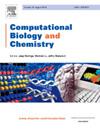In-silico discovery of efficient second-generation drug derivatives with enhanced antihistamine potency and selectivity
IF 2.6
4区 生物学
Q2 BIOLOGY
引用次数: 0
Abstract
The current study focuses on the potential of second-generation antihistamines, which exhibit fewer side effects compared to first-generation drugs, to block the Histamine H1 receptor (H1R) and mitigate allergic responses. We screened several derivatives of second-generation drugs taking Desloratadine (Deslo) and Acrivastine (Acra) as seed compounds. We performed molecular docking, drug-likeness, quantum chemical calculations, UV–visible and infrared spectroscopy, molecular electrostatic potential (MEP) mapping for understanding drug derivatives potential as efficient drugs and molecular dynamics (MD). The results depicted that among all Deslo1 showed best binding energy of −8.6 kcal/mol and best inhibition constant too. Moreover, LEU157 formed a conventional hydrogen bond with a ligand at distance of 2.51 Å in Deslo1. Deslo2 showed 95.2 % intestinal absorption which is quite good. None of the drugs showed any toxicity. The residues from catalytic site like Phe 116, Leu 154 and Leu 157 showed reasonably small fluctuations owing to their interactions with respective ligands. The RMSDs of Acra1 and Deslo2 mostly stay within 1Å range. For MD simulations best docked compounds (Acra1, Acra2, Deslo1 and Deslo2) were chosen and carried for 120 ns (120 ×106 fs). MD simulations trajectory is analyzed for the assessment of some important parameters like RMSD, RMSF, SASA, and RG. Moreover, ADMET analysis are performed to confirm their drug-like properties. The molecular geometries of Acra2 are optimized in gas phase as well as water solvent environments to simulate aqueous like conditions for optimized geometries. Significant differences are observed in the bond lengths and angles especially for polar functional groups, due to the solvation of hydrogen-bond donors and acceptors. The current study identify new therapeutic candidates for managing allergic rhinitis, which may evoke the scientific interests of scientists through in-vivo testing of hit drugs that were not explored previously.
在硅烷中发现抗组胺药效和选择性更强的高效第二代药物衍生物。
目前的研究重点是第二代抗组胺药的潜力,与第一代药物相比,它的副作用更少,可以阻断组胺H1受体(H1R)并减轻过敏反应。我们筛选了几种以地氯雷他定(Deslo)和吖伐他汀(Acra)为种子化合物的第二代药物衍生物。我们进行了分子对接、药物相似、量子化学计算、紫外可见和红外光谱、分子静电势(MEP)作图,以了解药物衍生物作为有效药物的潜力和分子动力学(MD)。结果表明,Deslo1具有-8.6 kcal/mol的最佳结合能和最佳抑制常数。此外,LEU157在Deslo1中与配体形成了距离为2.51 Å的常规氢键。Deslo2肠吸收率为95.2% %,效果良好。这些药物都没有显示出任何毒性。催化位点的残基如Phe 116、Leu 154和Leu 157由于与各自的配体相互作用而表现出相当小的波动。Acra1和Deslo2的rmsd大多在1Å范围内。为了进行MD模拟,选择了最佳的对接化合物(Acra1, Acra2, Deslo1和Deslo2)并携带120 ns(120 ×106 fs)。分析了MD仿真轨迹,对RMSD、RMSF、SASA、RG等重要参数进行了评估。此外,ADMET分析证实了它们的药物样性质。优化了Acra2在气相和水溶剂环境下的分子几何形状,模拟了优化几何形状的水环境。由于氢键给体和受体的溶剂化,在键长和键角上观察到显著的差异,特别是极性官能团。目前的研究确定了治疗变应性鼻炎的新候选药物,这可能会引起科学家的科学兴趣,通过对以前没有探索过的药物进行体内试验。
本文章由计算机程序翻译,如有差异,请以英文原文为准。
求助全文
约1分钟内获得全文
求助全文
来源期刊

Computational Biology and Chemistry
生物-计算机:跨学科应用
CiteScore
6.10
自引率
3.20%
发文量
142
审稿时长
24 days
期刊介绍:
Computational Biology and Chemistry publishes original research papers and review articles in all areas of computational life sciences. High quality research contributions with a major computational component in the areas of nucleic acid and protein sequence research, molecular evolution, molecular genetics (functional genomics and proteomics), theory and practice of either biology-specific or chemical-biology-specific modeling, and structural biology of nucleic acids and proteins are particularly welcome. Exceptionally high quality research work in bioinformatics, systems biology, ecology, computational pharmacology, metabolism, biomedical engineering, epidemiology, and statistical genetics will also be considered.
Given their inherent uncertainty, protein modeling and molecular docking studies should be thoroughly validated. In the absence of experimental results for validation, the use of molecular dynamics simulations along with detailed free energy calculations, for example, should be used as complementary techniques to support the major conclusions. Submissions of premature modeling exercises without additional biological insights will not be considered.
Review articles will generally be commissioned by the editors and should not be submitted to the journal without explicit invitation. However prospective authors are welcome to send a brief (one to three pages) synopsis, which will be evaluated by the editors.
 求助内容:
求助内容: 应助结果提醒方式:
应助结果提醒方式:


